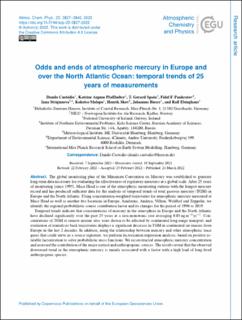| dc.contributor.author | Custódio, Danilo | |
| dc.contributor.author | Pfaffhuber, Katrine Aspmo | |
| dc.contributor.author | Spain, T. Gerard | |
| dc.contributor.author | Pankratov, Fidel F. | |
| dc.contributor.author | Strigunova, Iana | |
| dc.contributor.author | Molepo, Koketso | |
| dc.contributor.author | Skov, Henrik | |
| dc.contributor.author | Bieser, Johannes | |
| dc.contributor.author | Ebinghaus, Ralf | |
| dc.date.accessioned | 2022-04-04T12:15:46Z | |
| dc.date.available | 2022-04-04T12:15:46Z | |
| dc.date.created | 2022-03-30T13:11:03Z | |
| dc.date.issued | 2022 | |
| dc.identifier.citation | Atmospheric Chemistry and Physics (ACP). 2022, 22, 3827-3840. | en_US |
| dc.identifier.issn | 1680-7316 | |
| dc.identifier.uri | https://hdl.handle.net/11250/2989644 | |
| dc.description.abstract | The global monitoring plan of the Minamata Convention on Mercury was established to generate long-term data necessary for evaluating the effectiveness of regulatory measures at a global scale. After 25 years of monitoring (since 1995), Mace Head is one of the atmospheric monitoring stations with the longest mercury record and has produced sufficient data for the analysis of temporal trends of total gaseous mercury (TGM) in Europe and the North Atlantic. Using concentration-weighted trajectories for atmospheric mercury measured at Mace Head as well as another five locations in Europe, Amderma, Andøya, Villum, Waldhof and Zeppelin, we identify the regional probabilistic source contribution factor and its changes for the period of 1996 to 2019. Temporal trends indicate that concentrations of mercury in the atmosphere in Europe and the North Atlantic have declined significantly over the past 25 years at a non-monotonic rate averaging 0.03 . Concentrations of TGM at remote marine sites were shown to be affected by continental long-range transport, and evaluation of reanalysis back trajectories displays a significant decrease in TGM in continental air masses from Europe in the last 2 decades. In addition, using the relationship between mercury and other atmospheric trace gases that could serve as a source signature, we perform factorization regression analysis, based on positive rotatable factorization to solve probabilistic mass functions. We reconstructed atmospheric mercury concentration and assessed the contribution of the major natural and anthropogenic sources. The results reveal that the observed downward trend in the atmospheric mercury is mainly associated with a factor with a high load of long-lived anthropogenic species. | en_US |
| dc.language.iso | eng | en_US |
| dc.rights | Navngivelse 4.0 Internasjonal | * |
| dc.rights.uri | http://creativecommons.org/licenses/by/4.0/deed.no | * |
| dc.title | Odds and ends of atmospheric mercury in Europe and over the North Atlantic Ocean: temporal trends of 25 years of measurements | en_US |
| dc.type | Peer reviewed | en_US |
| dc.type | Journal article | en_US |
| dc.description.version | publishedVersion | en_US |
| dc.rights.holder | © Author(s) 2022. | en_US |
| dc.source.pagenumber | 3827-3840 | en_US |
| dc.source.volume | 22 | en_US |
| dc.source.journal | Atmospheric Chemistry and Physics (ACP) | en_US |
| dc.identifier.doi | 10.5194/acp-22-3827-2022 | |
| dc.identifier.cristin | 2013682 | |
| dc.relation.project | NILU: 110035 | |
| cristin.ispublished | true | |
| cristin.fulltext | original | |
| cristin.qualitycode | 2 | |

